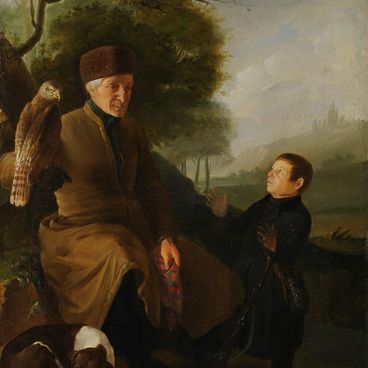On many ancient portraits, children were painted with unchildlike serious expressions. Artists often painted aristocrats’ sons in such a way, to show to the portrayed boys the ideal that they should strive for: smart, thoughtful and tidy young men, ready to serve “the Tsar and the Fatherland.”
The earnest boy in the picture is Vladimir Strukov, future Major General, a participant in the Crimean war and a successful government official.
Strukov was a respected man and achieved a lot in the positions of the Manager of the Astrakhan Chamber of State Property, and Governor of Vyatka and Vladimir provinces. No matter where he served, almshouses, schools, museums, hospitals and libraries opened everywhere on his initiative. Strukov was also the Chief Trustee of the Kalmyk people: he was a member of the state structure that controlled the territories of the Kalmyk steppes.
The public official did a lot for the Vladimir Region: he introduced a water supply system, opened an exhibition of manufactories and factories of the province, and founded the Vladimir Zemstvo girls’ secondary school. For these and other merits, Vladimir Strukov was the first in the history of the city to be awarded the title of Honorary Citizen of Vladimir.
However, the portrait hides the story of another person. On the canvas stretcher on the back of the painting you can see the inscription: ‘Property of the fifth grade student of the Vladimir secondary school Yanovich Daniil, 1898’ and, in a slightly different handwriting, ‘is donated to the Museum of the Vladimir Archival Commission. June 1900. Student of Saint-Petersburg University Yanovich Daniil.’
They were once made by the outstanding ethnographer Daniil Yanovich, but researchers have not yet established how Strukov’s childhood portrait found its way into his collection. Yanovich devoted his life to art, worked in many museums, collaborated with various ethnographic societies and people such as the founder of the Museum of Fine Arts Ivan Tsvetaev and the first People’s Commissar of Education of the RSFSR Anatoly Lunacharsky. Throughout his life, he collected many artifacts that are now included in the collections of the Museum of Anthropology and Ethnography named after Peter the Great (Kunstkamera), Vladimir Regional Museum and even among the best exhibits of the Russian Ethnographic Museum. But despite the collector’s achievements, he was arrested twice because of his sharp tongue and a freedom-loving character. Daniil Yanovich died in Kazakhstan, serving a sentence “for counter-revolutionary activities.”
The earnest boy in the picture is Vladimir Strukov, future Major General, a participant in the Crimean war and a successful government official.
Strukov was a respected man and achieved a lot in the positions of the Manager of the Astrakhan Chamber of State Property, and Governor of Vyatka and Vladimir provinces. No matter where he served, almshouses, schools, museums, hospitals and libraries opened everywhere on his initiative. Strukov was also the Chief Trustee of the Kalmyk people: he was a member of the state structure that controlled the territories of the Kalmyk steppes.
The public official did a lot for the Vladimir Region: he introduced a water supply system, opened an exhibition of manufactories and factories of the province, and founded the Vladimir Zemstvo girls’ secondary school. For these and other merits, Vladimir Strukov was the first in the history of the city to be awarded the title of Honorary Citizen of Vladimir.
However, the portrait hides the story of another person. On the canvas stretcher on the back of the painting you can see the inscription: ‘Property of the fifth grade student of the Vladimir secondary school Yanovich Daniil, 1898’ and, in a slightly different handwriting, ‘is donated to the Museum of the Vladimir Archival Commission. June 1900. Student of Saint-Petersburg University Yanovich Daniil.’
They were once made by the outstanding ethnographer Daniil Yanovich, but researchers have not yet established how Strukov’s childhood portrait found its way into his collection. Yanovich devoted his life to art, worked in many museums, collaborated with various ethnographic societies and people such as the founder of the Museum of Fine Arts Ivan Tsvetaev and the first People’s Commissar of Education of the RSFSR Anatoly Lunacharsky. Throughout his life, he collected many artifacts that are now included in the collections of the Museum of Anthropology and Ethnography named after Peter the Great (Kunstkamera), Vladimir Regional Museum and even among the best exhibits of the Russian Ethnographic Museum. But despite the collector’s achievements, he was arrested twice because of his sharp tongue and a freedom-loving character. Daniil Yanovich died in Kazakhstan, serving a sentence “for counter-revolutionary activities.”



